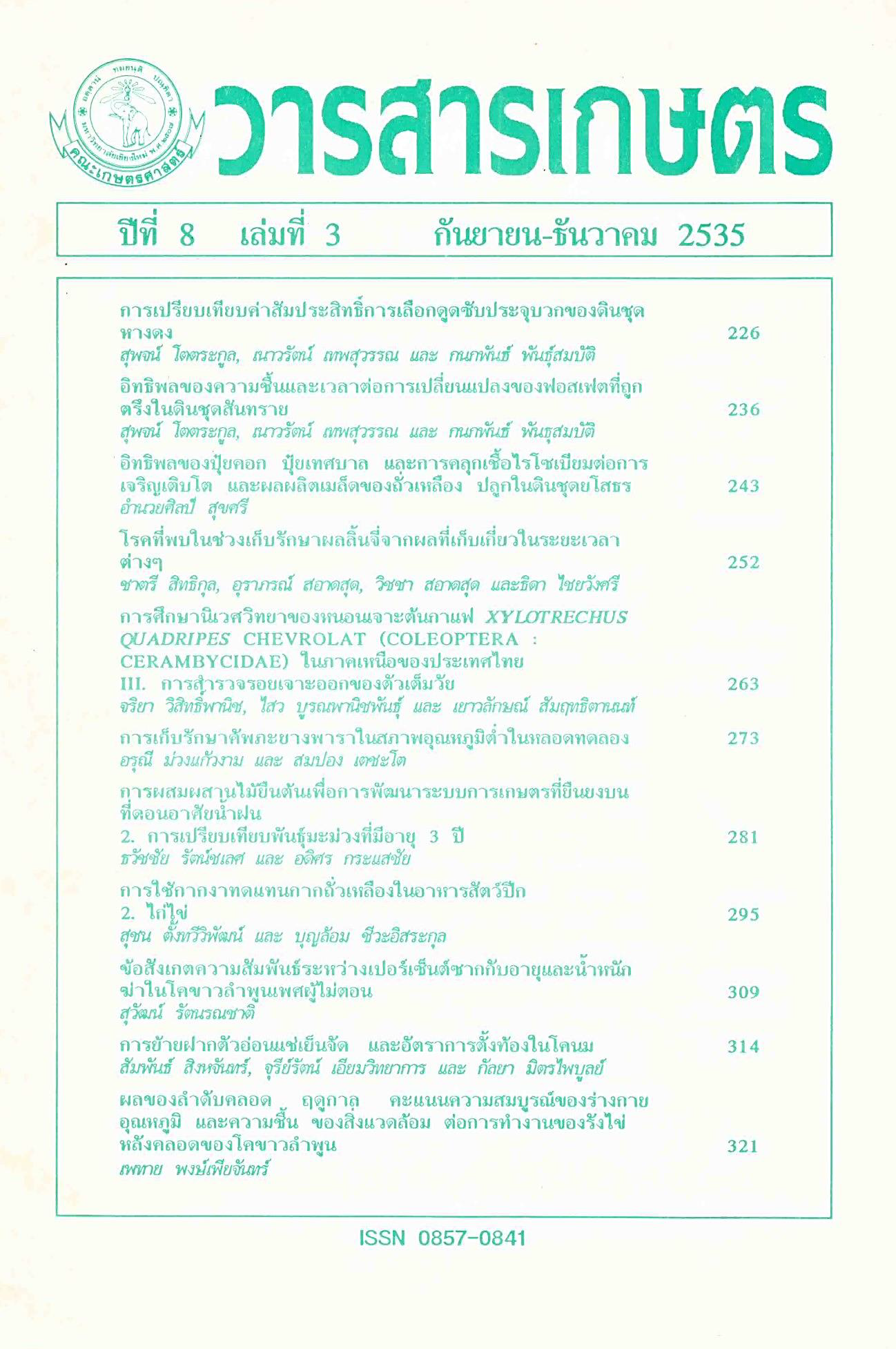ข้อสังเกตความสัมพันธ์ระหว่างเปอร์เซ็นต์ซากกับอายุและน้ำหนักฆ่าในโคขาวลำพูนเพศผู้ไม่ตอน
Main Article Content
บทคัดย่อ
ข้อมูลจากโคขาวลำพูนเพศผู้ไม่ตอนของฝูงมหาวิทยาลัยเชียงใหม่จำนวน 50 ตัว ถูกใช้ในการวิเคราะห์ความสัมพันธ์ระหว่างเปอร์เซ็นต์ซากกับอายุและน้ำหนักฆ่าในงานวิจัยนี้.
ผลจากการวิเคราะห์แสดงให้เห็นว่า เปอร์เซ็นต์ซากมีความสัมพันธ์ในทางบวกกับน้ำหนักฆ่า (r =.4172) สูงกว่ากับอายุฆ่า (r = .2664) อิทธิพลของน้ำหนักฆ่าเท่านั้นที่มีนัยสำคัญทางสถิติต่อเปอร์เซ็นต์ซากผลสรุปของการวิเคราะห์ครั้งนี้คือ โคขาวลำพูนเพศผู้ไม่ตอน ถ้าเป็นไปได้ ควรถูกฆ่าที่อายุน้อย ๆ และน้ำหนักตัวมาก ๆ เพราะจะทำให้ได้เปอร์เซ็นต์ซากสูง คุณภาพซากดี และประหยัดค่าอาหารในการเลี้ยง จุดที่พอเหมาะระหว่างอายุและน้ำหนักฆ่าเมื่อคำนึงถึงลักษณะเหล่านี้นั้น น่าจะได้มีการวิจัยต่อในอนาคต.
Article Details
ประเภทบทความ
บทความวิจัย
เอกสารอ้างอิง
คันธพนิต, ชัยณรงค์., ยิ้มมงคล, สมิต. และผ่องลำเจียก, เสาวลักษณ์. (2533). รายงานเบื้องต้นค่าสังเกตการขุน และคุณภาพซากของโคพันธุ์แบรงกัสอายุ 4 ปี. วารสารโคกระบือ. 2:68.
รัตนชาติ, สุวัฒน์. (2527). ลักษณะและความสัมพันธ์ระหว่างลักษณะของโค-กระบือไทย. วิทยานิพนธ์ปริญญาโท มหาวิทยาลัยเกษตรศาสตร์.
จตุรสิทธา, สัญชัย., โพธิกานนท์, นิรันดร. และ มิเกล็ด, โชค. (2532). การศึกษาคุณภาพซากโคขาวลำพูน: การศึกษาเปรียบเทียบการตัดแต่งซากแบบไทยและสากล. วารสารเกษตร, 5: 171.
มหาวิจิตร, วิเชียร. (2535). การเพิ่มโปรตีนของมันสำปะหลังเส้นบดโดยน้ำกากผงชูรสเพื่อใช้เป็นอาหารโค. วิทยานิพนธ์ปริญญาโท มหาวิทยาลัยเกษตรศาสตร์.
อินทร์สังข์, องอาจ. (2535). การใช้กากไลซีนเพิ่มโปรตีนของมันสำปะหลังในอาหารโค. วิทยานิพนธ์ปริญญาโท มหาวิทยาลัยเกษตรศาสตร์.
Dikeman, M.E., Reddy, G.B., Arthaud, V.H., Tuma, H.J., Koch, R.M., Mandigo, R.W. and Axe, J.B. (1986). Longissimus muscle quality, palatability and connective tissue histological characteristics of bulls and steers fed different energy levels and slaughtered at four ages. J. Anim. Sci. 63:92.
Field, R.A., and Schoonover, C.O. (1967). Equations for comparing longissimus dorsi area in bulls of different weights. J. Anim. Sci. 26: 709.
Hansen, K. R., and Zinn, D.W. (1968). Effect of feeding regime on production and carcass traits of light weight calves. J. Anim. Sci. 27: 133. (Abst)
Kendall, M., and Stuart, A. (1979). The advanced theory of statistics. Vol. 1. 4th ed. MacMillan Pibl. Co., Inc., New York, NY.
Luitingh, H. C. (1962). Developmental changes in beef steers as influenced by fattening, age and type of ration. J. Agric. Sci. 58: 1.
Luitingh, H. C. (1963). The efficiency of beef production in terms of carcass weight increase as influenced by the ration concentration and the age of steers. J. Agric. Sci. 61: 127.
Levi, D., Soller, M. and Shilo, A. (1967). The effect of age, live weight and rate of gain on dressing percentage and non-saleable fat content of Israel-Friesian bull calves. Anim. Prod. 9: 115.
Rattanaronchart, S. (1982). Genetic and genetic-feeding regimen interaction effects on lactation, growth and carcass traits in dairy cattle. Ph.D. Diss., Univ. of Illinois, Urbana.
Seebeck, R.M., and Tulloh, N.M. (1966). The representation of yield of dressed carcass. Anim. Prod. 8: 281.
Tulloh, N.M. (1964). The carcass composition of sheep, cattle and pigs as functions of body weight. Tech. Conf. on Carcass Composition and MeatAppraisal of Meat Animals, Melbourne. (Cited after Preston and Willis. 1970. Intensive Beef Production. Pergamon Press, page 32).
Willis, M.B., Preston, T.R., Martin, J.L. and Velazquez, M. (1968). Carcass compositon of Brahman bulls fed high energy diets and slaughtered at different live weights. Rev. cubana Cienc. Agric. (Eng. Ed.) 2:83. (Cited after Preston and Willis. 1970. Intensive Beef Production. Pergamon Press, page 32)
Zerle, L. Carpenter. (1973). Effects of crossbreeding on carcass characteristics. Crossbreeding Beef Cattle Series 2, Univ. of Florida Press, Gainsville.
รัตนชาติ, สุวัฒน์. (2527). ลักษณะและความสัมพันธ์ระหว่างลักษณะของโค-กระบือไทย. วิทยานิพนธ์ปริญญาโท มหาวิทยาลัยเกษตรศาสตร์.
จตุรสิทธา, สัญชัย., โพธิกานนท์, นิรันดร. และ มิเกล็ด, โชค. (2532). การศึกษาคุณภาพซากโคขาวลำพูน: การศึกษาเปรียบเทียบการตัดแต่งซากแบบไทยและสากล. วารสารเกษตร, 5: 171.
มหาวิจิตร, วิเชียร. (2535). การเพิ่มโปรตีนของมันสำปะหลังเส้นบดโดยน้ำกากผงชูรสเพื่อใช้เป็นอาหารโค. วิทยานิพนธ์ปริญญาโท มหาวิทยาลัยเกษตรศาสตร์.
อินทร์สังข์, องอาจ. (2535). การใช้กากไลซีนเพิ่มโปรตีนของมันสำปะหลังในอาหารโค. วิทยานิพนธ์ปริญญาโท มหาวิทยาลัยเกษตรศาสตร์.
Dikeman, M.E., Reddy, G.B., Arthaud, V.H., Tuma, H.J., Koch, R.M., Mandigo, R.W. and Axe, J.B. (1986). Longissimus muscle quality, palatability and connective tissue histological characteristics of bulls and steers fed different energy levels and slaughtered at four ages. J. Anim. Sci. 63:92.
Field, R.A., and Schoonover, C.O. (1967). Equations for comparing longissimus dorsi area in bulls of different weights. J. Anim. Sci. 26: 709.
Hansen, K. R., and Zinn, D.W. (1968). Effect of feeding regime on production and carcass traits of light weight calves. J. Anim. Sci. 27: 133. (Abst)
Kendall, M., and Stuart, A. (1979). The advanced theory of statistics. Vol. 1. 4th ed. MacMillan Pibl. Co., Inc., New York, NY.
Luitingh, H. C. (1962). Developmental changes in beef steers as influenced by fattening, age and type of ration. J. Agric. Sci. 58: 1.
Luitingh, H. C. (1963). The efficiency of beef production in terms of carcass weight increase as influenced by the ration concentration and the age of steers. J. Agric. Sci. 61: 127.
Levi, D., Soller, M. and Shilo, A. (1967). The effect of age, live weight and rate of gain on dressing percentage and non-saleable fat content of Israel-Friesian bull calves. Anim. Prod. 9: 115.
Rattanaronchart, S. (1982). Genetic and genetic-feeding regimen interaction effects on lactation, growth and carcass traits in dairy cattle. Ph.D. Diss., Univ. of Illinois, Urbana.
Seebeck, R.M., and Tulloh, N.M. (1966). The representation of yield of dressed carcass. Anim. Prod. 8: 281.
Tulloh, N.M. (1964). The carcass composition of sheep, cattle and pigs as functions of body weight. Tech. Conf. on Carcass Composition and MeatAppraisal of Meat Animals, Melbourne. (Cited after Preston and Willis. 1970. Intensive Beef Production. Pergamon Press, page 32).
Willis, M.B., Preston, T.R., Martin, J.L. and Velazquez, M. (1968). Carcass compositon of Brahman bulls fed high energy diets and slaughtered at different live weights. Rev. cubana Cienc. Agric. (Eng. Ed.) 2:83. (Cited after Preston and Willis. 1970. Intensive Beef Production. Pergamon Press, page 32)
Zerle, L. Carpenter. (1973). Effects of crossbreeding on carcass characteristics. Crossbreeding Beef Cattle Series 2, Univ. of Florida Press, Gainsville.


